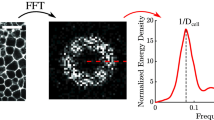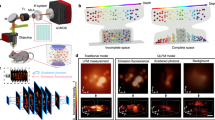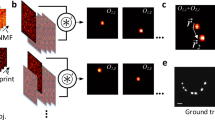Abstract
Absorption and scattering of light by tissue as well as limitations in the resolution of the optical system influence the appearance of tissue embedded objects in fluorescence images and may reduce the accuracy of measurements from these images. Although the principles of light scattering in tissue and optical resolution are well known, the interplay between the two in fluorescence imaging in an imaging cryomicrotome is not well understood. In this paper we present and investigate an image formation model in a reflection geometry, like an imaging cryomicrotome, that takes both light scattering by tissue as well as the point spread function of the lens into account. The validity of the model was investigated by comparison of diameter estimates of fluorescent cylinders as obtained from images acquired in a reflection geometry with those estimated from simulated images. The results reveal that diameter values estimated from the simulated images are in excellent agreement with the experimental estimates. Our approach in modeling the image formation process of embedded fluorescent structures allows for the prediction of accuracy of quantitative estimates from fluorescence images. The relationship between imaging parameters and bias can be applied to arrive at accurate diameter estimates of near cylindrical structures like blood vessels.









Similar content being viewed by others
References
Bernard SL, Ewen JR, Barlow CH, Kelly JJ, McKinney S, Frazer DA, Glenny RW (2006) High spatial resolution measurements of organ blood flow in small laboratory animals. Am J Physiol Heart Circulat Physiol 279:H2043–H2052
Born M, Wolf E (1980) Principles of optics. Academic Press, San Diego
Eidsath A, Chernomordik V, Gandjbakhche A, Smith P, Russo A (2002) Three-dimensional localization of fluorescent masses deeply embedded in tissue. Phys Med Biol 47(22):4079–4092
Faber DJ, van der Meer FJ, Aalders MC, van Leeuwen TG (2004) Quantitative measurement of attenuation coefficients of weakly scattering media using optical coherence tomography. Opt Express 12:4353–4365
Kelly JJ, Ewen JR, Bernard SL, Glenny RW, Barlow CH (2000) Regional blood flow measurements from fluorescent microsphere images using an imaging cryomicrotome. Rev Sci Instrum 71(1):228–234
van Leeuwen TG, Faber DJ, Aalders MC (2003) Measurement of the axial point spread function in scattering media using single mode fiber based optical coherence tomography. IEEE J Sel Top Quant Electr 9:227–233
Massoud TF, Gambhir SS (2003) Molecular imaging in living subjects: seeing fundamental biological processes in a new light. Genes Dev 17(5):545–580
Press WH, Teukolsky SA, Vetterling WT, Flannery BP (1992) Numerical recipes in C. Cambridge University Press, New York
Shimizu K, Tochio K, Kato Y (2005) Improvement of transcutaneous fluorescent images with a depth dependent point-spread function. Appl Opt 44(11):2154–2161
Spaan JAE, ter Wee R, van Teeffelen JWGE, Streekstra G, Siebes M, Kolyva C, Vink H, Fokkema DS, VanBavel E (2005) Visualisation of intromural coronary vasculature by an imaging cryomicrotome suggests compartmentalisation of myocardial perfusion areas. Med Biol Eng Comput 43(4):431–435
Streekstra GJ, van Pelt J (2002) Analysis of tubular structures in three-dimensional confocal images. Netw Comput Neural Syst 13(3):381–395
Streekstra GJ, van den Boomgaard R, Smeulders AWM (2001) Scale dependency of image derivatives for feature measurement in curvilinear structures. Int J Comp Vis 42(3):177–189
Streekstra GJ, Brascamp P, van der Leij C, ter Wee R, Strackee SD, Maas M, Venema HW (2004) Cartilage thickness measurement in the sub-millimeter range. Lect Notes Comp Sci 3217(2):950–958
van Vliet L, Verbeek P (1994) Edge localization by mog filters: Multiple-of-gaussians. Pattern Recognit Lett 15:485–496
Author information
Authors and Affiliations
Corresponding author
Rights and permissions
About this article
Cite this article
Rolf, M.P., ter Wee, R., van Leeuwen, T.G. et al. Diameter measurement from images of fluorescent cylinders embedded in tissue. Med Biol Eng Comput 46, 589–596 (2008). https://doi.org/10.1007/s11517-008-0328-9
Received:
Accepted:
Published:
Issue Date:
DOI: https://doi.org/10.1007/s11517-008-0328-9




